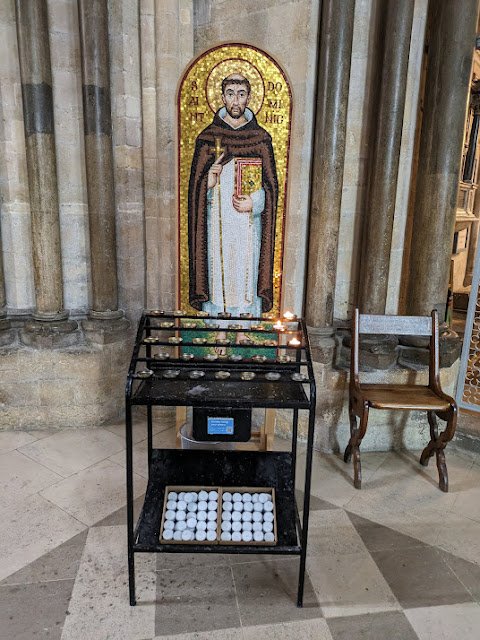 Here are some photo's of a new mosaic just installed in Wales, designed and made by Aidan Hart. (H/t David Woolf) I have taken the them from his website, here. Aidan's photos give us a sense of how it was produced as well as the what the final product looks like. The church, St Martins is an Anglican church in Cardiff on a town street and the mosaic is on the exterior. I like this - we must not underestimate the power of beauty and the face of Christ especially to draw people in to God. I found a photo of the church before the mosaic was placed there on the internet, see below. I hope the congregation will not think it is undignified that it includes in the pawn shop nextdoor. I personally think that the juxtaposition of the mosaic and shop emphases how we must think about beauty reaching out and touching people in the everyday activities of life and competing with all the advertising and other imagery that is out there.
The method that Aidan used, if I have understood him correctly, is the 'Ravenna' or 'double reverse' method that involves putting tracing the design onto a temporary wet 'putty 'base (a slow drying mortar or plaster) and then placing the tesserae into the putty so that the artist can see the design developing as it would be seen eventually. Then a piece of glued linen is stuck to what is now the open face. The mosaic is turned over (carefully) and the putty is removed. This leaves a reverse image stuck to the linen. So far, all of this work is done in the studio. Now the mosaic, is placed into the mortar in situ. This means that the linen is facing outwards and the tesserae are pushed into the wall. Once this has set, then the linen is removed and the side of the tesserae that is open to the air is cleaned and you have the final image.
Here are some photo's of a new mosaic just installed in Wales, designed and made by Aidan Hart. (H/t David Woolf) I have taken the them from his website, here. Aidan's photos give us a sense of how it was produced as well as the what the final product looks like. The church, St Martins is an Anglican church in Cardiff on a town street and the mosaic is on the exterior. I like this - we must not underestimate the power of beauty and the face of Christ especially to draw people in to God. I found a photo of the church before the mosaic was placed there on the internet, see below. I hope the congregation will not think it is undignified that it includes in the pawn shop nextdoor. I personally think that the juxtaposition of the mosaic and shop emphases how we must think about beauty reaching out and touching people in the everyday activities of life and competing with all the advertising and other imagery that is out there.
The method that Aidan used, if I have understood him correctly, is the 'Ravenna' or 'double reverse' method that involves putting tracing the design onto a temporary wet 'putty 'base (a slow drying mortar or plaster) and then placing the tesserae into the putty so that the artist can see the design developing as it would be seen eventually. Then a piece of glued linen is stuck to what is now the open face. The mosaic is turned over (carefully) and the putty is removed. This leaves a reverse image stuck to the linen. So far, all of this work is done in the studio. Now the mosaic, is placed into the mortar in situ. This means that the linen is facing outwards and the tesserae are pushed into the wall. Once this has set, then the linen is removed and the side of the tesserae that is open to the air is cleaned and you have the final image.
I remember that when I was in Aidan's classes he always used to stress how valuable it was for painters to study mosaics if they wanted to discern what colours contributed to particular effects, for example, flesh colours. Sometimes when you study paintings it is difficult to discern exactly what combinations have produced the final colour because with paint one wash is placed over another and you only see the combination, but can't see what is below the surface and has contributed to that effect. With mosaic, however, tesserae of pure colour are used to created a pixelated image and the combined effect is created in the mind's eye. So for example, a green effect might be created by having no green tesserae at all, but rather by having alternately pure blue and pure yellow tesserae sitting next to each other. When I gain a general impression I will 'see' green, but when I examine particular areas closely enough to resolve individual tesserae, I will see only blue and yellow. As painter, I can look at this and create that particular green in my icon by using a the same blue and yellow but in alternate transparent washes.



Above: work in progress - putting the tesserae into the base putty

The reversed image stuck to the linen, with the base putty removed and before being placed into its final position on the church





















